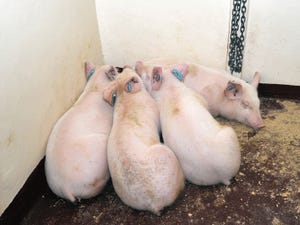Tips for Handling Early Weaned Pigs
Weaning pigs early in the face of PEDV requires TLC.

When pork producers experience an outbreak of porcine epidemic diarrhea virus (PEDV) in a herd, a common strategy used to stop the disease from spreading is to quickly wean all piglets who have not yet contracted the disease and move them out of the facility. Consequently, some piglets are moving to the nursery as young as 7 days of age. Weaning younger, more vulnerable piglets means extra attention to detail and some tender loving care (TLC) is needed to get pigs off to a good start.
Matt Grimm, associate director of production for Professional Swine Management in Carthage, IL, shared tips for success when working with early weaned pigs during the recent Swine Health and Production Conference, sponsored by Carthage Veterinary Service.
Grimm says the secret to success really isn’t so “secret” at all. “It really is all about going back to the basics,” he explains. “Ultimately, these are the things we should have been doing when it comes to pig care anyway. We are just going to be doing it more frequently and more intensively in the face of PEDV.”
He says the first, most obvious step involves moving pigs in clean trucks or trailers. Once the piglets arrive at the new facility, there are some basic actions that producers can take to help maximize the chances of survivability.
“One of the things I’ve learned is to keep things simple, make sure we have a plan in place and execute that plan,” Grimm says. “On the onset of a break we will be weaning pigs from as young as 7 days of age all the way up to 21 days of age. We need to be prepared with our diets on our farms and work with a nutritionist to make sure we are set up to feed the pigs properly, based on the age of the pigs, and it may be a significantly different feeding strategy than we would have had previously.”
Grimm says a lot more intensive care goes on in facilities during a break. He follows three basic, general rules for providing that extra TLC:
Keep the barn hot.
Keep the barn dry.
Keep the pigs hydrated.
“If we can follow those three basic rules of thumb, we can be successful,” he says.
Barn Environment
Prior to the arrival of the pigs, Grimm makes sure barns are heated to a set point of at least 85 degrees Fahrenheit. Keeping pigs comfortable from the beginning helps reduce stress. “It’s really important, not only in the face of a PEDV break, but for any pig that has a negative challenge, not to chill that pig and cause additional stress because that amplifies that negative effect, whether it is PEDV, PRRS (porcine reproductive and respiratory syndrome), etc.,” he explains. “I like to preheat the barn to 85 degrees Fahrenheit as a set point and increase the set point by 2 to 4 degrees until pigs are comfortable. Evaluate how the pigs are doing in that facility and make adjustments to those temperatures from there. Based on how the pigs are doing, you can dial temperatures back down gradually as pigs get older.”
Grimm also makes sure he and his staff are providing adequate zone temperatures in each building. “Zone temperature at pig-level will need to be close to 95 degrees Fahrenheit,” he says. “Whether you are using brooders, or heat lamps or just putting them in a nursery facility, let’s make sure that every pig is comfortable. I’m going to say it again; any of those pigs that we continue to stress are going to go in the wrong direction, healthwise.”
Grimm reminds producers to measure the humidity in each room, too. He aims for a target humidity reading between 50-60%. “Trying to reduce the humidity levels in the barn, while still keeping it warm enough for the pigs, can be a bit of a challenge, especially in the wintertime when a lot of viruses are coming through. A lot of times when I turn the temperature levels up in the buildings it will actually burn some of that humidity out of there,” he notes.
As a way to help keep pigs comfortable and free from drafts while lying on the slats, Grimm advocates for liberal use of piglet mats. He says the ideal target would be to provide 0.5 sq. ft. of mat space per pig.
“Let’s make sure those pigs have the best and largest area possible to lay where they can be the most comfortable,” he says.
Pig Care
In order to make sure smaller or weaker pigs are not going to lose out in the competitive environment in the pens, Grimm says he and his staff sort off the lightest 10% of pigs at the time of initial placement in the barn to go into pens in the center of the barn where they can receive additional attention. He also leaves 10% of the pens in the barn open as a place to move additional pigs that appear to be falling behind. “It seems we will especially see some pigs falling behind in those first four to seven days in the barn,” Grimm says.
Grimm makes sure pigs are learning to eat and drink by using gruel and mat feeding. He says it is important for caregivers to make sure all pigs are getting up and being encouraged to move to the gruel feeders. “Right at the onset, if you can get those pigs up and make them eat and drink every two hours on a 24-hour cycle, that works best. I like to get them up and stimulate them to eat and drink because it gives them a huge advantage. Realize the pigs are going to be weaker upon initial arrival, so plan on monitoring them closely for four to five days, minimum. It’s no different if I’m not feeling well, and lying on the couch, and the last thing I’m going to want to do is get up to eat and drink, even though it is important. If you can get them up, you can make sure they are getting hydrated and help make sure they are getting nutrients into their bodies, which is extremely crucial.”
Mat Feeding
Even though Grimm feeds pellets on mats to encourage pigs to learn to eat, he does so on a limited basis. “I’m not a fan of putting a lot of feed on the mat. The reason is because I look at mat feeding as stimulation for pigs to get up and eat and drink. If I put too much feed on that mat, the likelihood that pigs are going to move away from that mat goes down,” he explains. “Pigs might nibble a little on it, but they are going to look at it as bedding. They may nibble and then lay back down. Then the pigs don’t have the incentive to get up to go find feed and water. The likelihood that you are going to get them to go get gruel and drink water goes down if you are putting too much feed on the mats.”
Grimm believes in providing feed in gruel form until all pigs in the pen have developed good body condition that can clearly be seen, as he describes it, in their “full bellies.” He says it may take anywhere from four to 12 days for pigs to get to this point. He also encourages producers not to overfeed the gruel.
He stresses the importance of pig caregivers getting into the pen to make sure pigs get up and move to the feed every two hours when the gruel is provided. “Push the pigs to the feed and water. Don’t just put that gruel pan over the gate from the aisle and walk away,” he says. “Get the pigs up. Push the gruel pan to the back of the pen to encourage the pigs to walk to the gruel. Get those pigs trained to get away from the ‘couch.’ Stimulate them to get up and move around because they will feel better.” Because it is important to both keep feed fresh and appealing to the pigs and to also keep them healthy, Grimm says he only puts enough gruel in the pan for pigs to have eaten it all within 20 to 30 minutes. “The reason I do that is that I don’t want it to go sour. You also get the pigs in the habit of getting up and going to that gruel. It’s no different than putting a bowl of cereal on the counter and leaving it all day and then coming back to eat it. You aren’t going to like it very much. You’ve got to keep the gruel pans clean and the feed fresh. You don’t want pigs to get further challenged from a dirty pan.”
Grimm reinforces that water is also an important part of starting pigs successfully. He believes it is helpful to drip or leak a nipple waterer until pigs learn how to find the water source. However, this practice becomes a balancing act between providing the incentive and creating a wet, moist area that could chill pigs. “Make it accessible, but don’t make it a wet area for the pigs. We want to keep it hot and dry. If we’ve got a gruel pan and a waterer in an area next to where my pigs are lying, it can have a negative impact on the pigs because it drastically reduces the temperature that those pigs are experiencing.” Grimm suggests dripping/leaking one nipple waterer per 50 head of pigs for five days. Water pressure should be around 15 psi for best results.
Health
Even though the pigs coming in may have been exposed to PEDV, Grimm says producers should not assume that all episodes of scouring that may occur in the barn are PEDV. “There may be other secondary infections,” he says. “Treat accordingly for secondary infections such as Salmonella, E. coli, etc., working with your veterinarian as needed.”
Grimm says in approximately four days post-placement, most pigs will start to improve rapidly and will be off to a good start. He says any pigs that are lagging behind after four days should be separated off and given a chance to be successful in a smaller pen where they don’t have to compete as much for feed or water.
He reminds producers that managing pigs following early weaning and a PEDV outbreak means following the basics of starting pigs who have been weaned more conventionally, just implementing procedures more frequently.
“It’s pretty basic, fundamentals of starting pigs. Make sure the pigs are comfortable and keep them hydrated,” he says. “We’ve all been impacted negatively by PEDV, and we have all learned a lot over the past 1½ years. I think once we get through the challenge of PEDV, we are going to be that much better as a production system because it has forced us to go back and get better at the basics of pig care.”
About the Author(s)
You May Also Like



